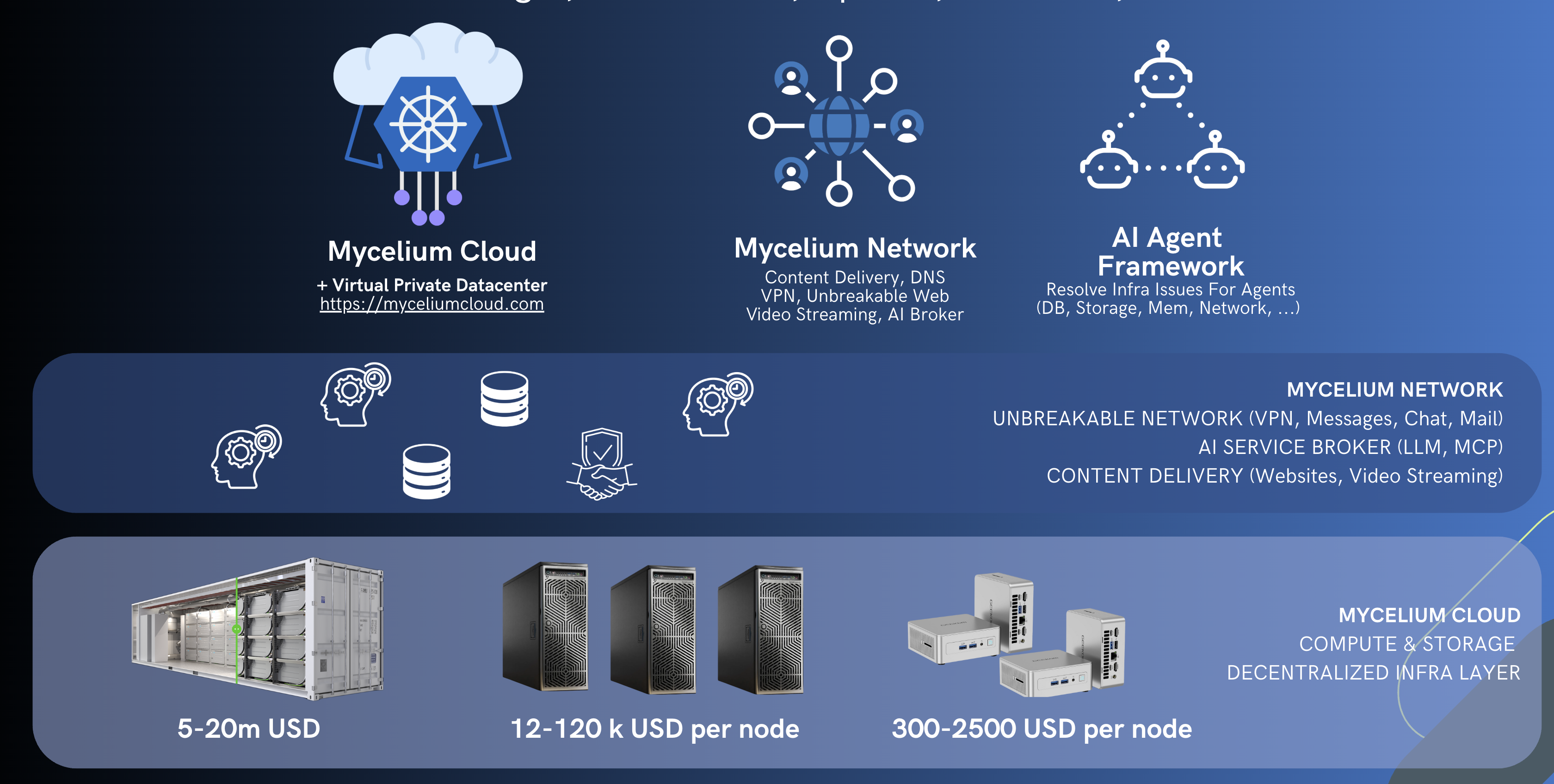
VDC Architecture
1. Purpose
The Mycelium Architecture defines a new model for cloud and network infrastructure — one that is sovereign, decentralized, and resilient.
It replaces centralized hyperscaler data centers (Google Cloud, AWS, Azure, etc.) with a distributed global fabric of compute, storage, and network nodes.
The result is a system capable of hosting applications, data, and AI services without single points of failure or control.
Mycelium Architecture merges decentralized compute, unbreakable networking, and autonomous management into one coherent system.
By distributing workloads across independently owned nodes and ensuring global coordination through the Mycelium Network and AI Agent Framework, it enables a new generation of sovereign digital infrastructure — one that is open, efficient, and resistant to failure or control.
2. Architectural Layers
The Mycelium architecture is built on three integrated layers:
A. Mycelium Cloud
(Compute + Storage Layer)
The foundational layer provides virtualized compute and storage resources across a distributed network of independently owned hardware nodes.
Key Characteristics:
- Fully decentralized: Nodes can be hosted in homes, offices, and datacenters.
- Composable resources: CPU, GPU, RAM, and storage pooled dynamically.
- Energy-efficient & sovereign: No centralized power dependency; each node operates within its own jurisdiction.
- Interoperable: Compatible with standard orchestration systems like Kubernetes and Docker.
Node Types and Costs:
| Node Type | Typical Cost | Description |
|---|---|---|
| Tier-S (Container Datacenter) | 5–20 M USD | Full data-center-in-a-box deployment with 100–500 nodes. |
| Tier-H (Rack/Server Node) | 12–120 K USD | High-performance standalone or clustered server node. |
| Tier-E (Edge Node) | 300–2,500 USD | Small edge node for local compute or storage. |
Function:
All nodes collectively form the Mycelium Cloud, providing on-demand virtual machines, containers, databases, and application workloads.
B. Mycelium Network
(Connectivity + Routing Layer)
The network layer interconnects all Mycelium Cloud nodes through an unbreakable overlay network that is independent of traditional ISPs or centralized routing authorities.
Key Functions:
- VPN and private communication (secure end-to-end connectivity)
- Decentralized DNS and routing (resilient against outages or censorship)
- Content Delivery Network (CDN) for web, video, and application streaming
- Service Broker for connecting distributed workloads and AI services
Core Advantage:
Even if parts of the internet are disrupted, applications and data hosted in the Mycelium ecosystem continue to operate and remain discoverable.
C. AI Agent Framework
(Automation + Operations Layer)
The AI Agent Framework provides autonomous management and coordination for infrastructure and services.
Responsibilities:
- Monitor system health and performance
- Detect and resolve network or storage anomalies
- Optimize resource allocation dynamically
- Manage service discovery and coordination across nodes
Benefit:
The AI Agent Framework ensures high availability and self-recovery without human intervention, reducing operational complexity.
3. System Flow
-
Deployment: Applications, containers, or VMs are deployed into the Mycelium Cloud.
The system automatically allocates compute and storage resources from available nodes. -
Networking: Traffic is routed through the Mycelium Network’s overlay layer, ensuring privacy and redundancy.
All communication is encrypted and optimized via shortest-path routing. -
Service Operations: The AI Agent Framework continuously monitors all active nodes and workloads.
If a node fails or goes offline, workloads are automatically migrated and rebalanced. -
Delivery: End-users access applications, content, and data through the Mycelium Network CDN and DNS system.
This ensures consistent performance globally, independent of traditional cloud infrastructure.
4. Unique Architectural Principles
| Principle | Description |
|---|---|
| Sovereign | Every node operates under its host’s jurisdiction, enabling compliance and data control. |
| Decentralized | No single company owns or controls the infrastructure — it is collectively operated. |
| Self-Healing | Failures are automatically mitigated through redundancy and distributed management. |
| Scalable | Resources can scale linearly by adding more nodes of any type. |
| Interoperable | Uses open standards for compute, storage, and network orchestration. |
| Cost-Efficient | Distributed resource ownership drastically reduces CAPEX and OPEX. |
5. Example Use Cases
- Sovereign Cloud Hosting for governments and cooperatives.
- Enterprise Private Cloud without reliance on hyperscalers.
- Edge Computing for IoT, smart cities, and remote AI inference.
- Content Distribution (websites, media, live video, CDN).
- Resilient Communication Networks (VPN, chat, email).